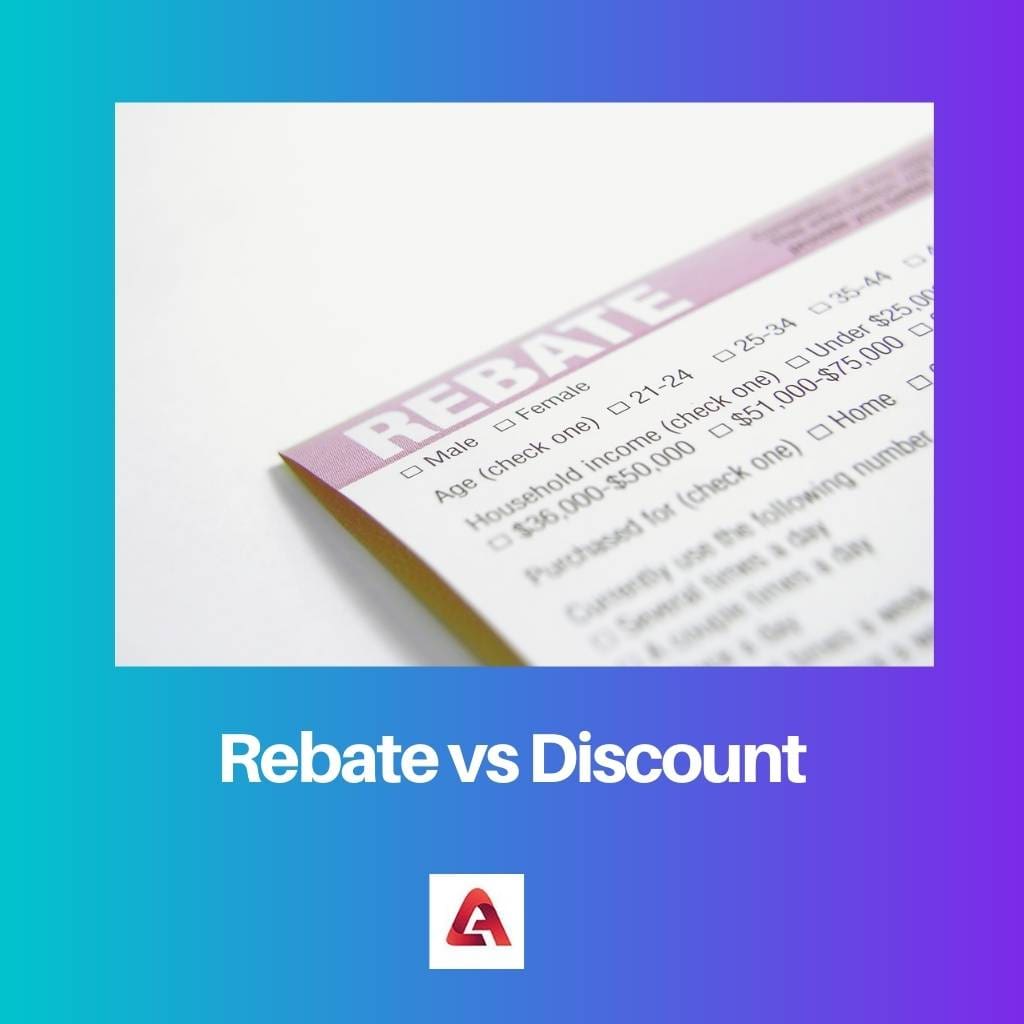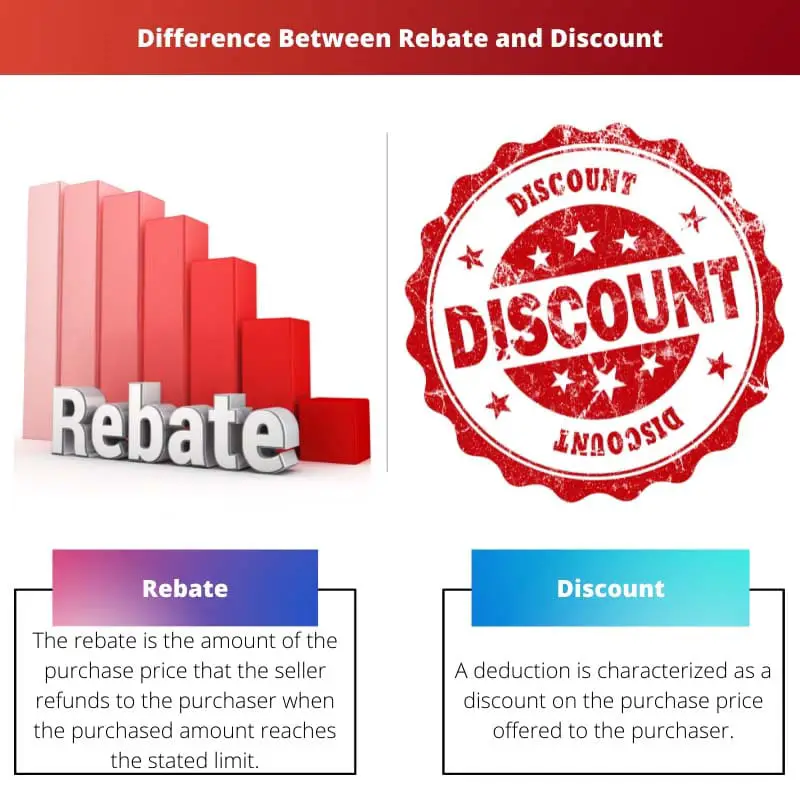Sales maximization is the main corporate goal for which the organization follows numerous strategies.
One of these techniques is to provide the shoppers with a discount or a discount to purchase more things. Rebate is the most popular approach companies employ to increase their sales when the product’s price is deducted.
The reimbursement, however, is a specific form of discount or is partly a reimbursement by the buyer of the product price provided for those clients whose purchases surpass the stipulated volume or amount.
Whenever you get a price decrease when buying, this is a discount, but in fact, it is a discount. Thus the difference between discount and rebate has to be known to every client and seller.
Key Takeaways
- Rebates are refunds offered to customers after a purchase is made, while discounts are reductions in price given at the time of purchase.
- Rebates can be offered as cash, store credit, or a check, whereas discounts directly reduce the purchase price.
- Rebates require customers to complete additional steps, such as mailing in a form or submitting a claim online, while discounts are automatically applied at the point of sale.
Rebate vs Discount
A rebate is a refund of part of the purchase price, provided after the purchased product or service. It is a common marketing strategy. Discount is another marketing strategy based on reducing the purchase price of a product or service applied at the time of purchase.

The rebate is a kind of allowance for items purchased by clients at the prices of the catalogue, and the assessee for tax paid or rental paid for the amount paid more than the amount to be paid.
The rebate shall be paid. The rebate is permitted for consumers to meet a specific limit if the purchase is in volume or value. The sum that the vendor returns to the buyer when the purchases are paid in full is a refund.
A discount is paid where the sum awarded exceeds the service rendered. Sometimes sales volumes are increased, or old clients are rewarded. The seller’s concession permitted on the invoice’s nutrient value is called a discount.
The gross amount of the product is specified, and the buyer must pay the net price of the product equal to gross less discount.
Comparison Table
| Parameters of Comparison | Rebate | Discount |
|---|---|---|
| Meaning | The rebate is the amount of the purchase price that the seller refunds to the purchaser when the purchased amount reaches the stated limit. | A deduction is characterized as a discount on the purchase price offered to the purchaser. |
| Customers specific | It is not possible to achieve the given limit unless the value of the product or amount is purchased. | Every product the buyer purchases. |
| Listing in the account book | It appears separately, as provided once the sale has been registered, in the financial accounts. | In the cases of a commercial discount, a cash discount is not indicated in the account books, but an expense in the return. |
| Timing | It is used following the recording of an event, i.e. after the sale or purchase is finished. | It is used when an event occurs, i.e. before completion of the sale or purchase. |
| Consideration | All the motives for a trade are taken into account. | A commercial discount for the quantity purchased is granted. Given the time of payment, a cash discount is granted. |
What is Rebate?
A rebate is the repayment of goods or services purchased. After the purchase amount has been paid in full, the consumer receives a rebate. The rebate might be used to encourage the purchase of several items at once.
A computer, a printer, and a voucher can be bought together, and a rebate on the costs of the printer can be granted.
The rebate is paid only when the item has been paid as a full-cost return. If they pay more than the amount requested, customers may also obtain a rebate for services. This category includes taxes and services.
Especially after the goods or services are purchased in full, the consumer will only be paid back the money. A way to encourage good interactions with customers.
Each refund might be used individually, based on the seller and buyer agreement for the given services. You always receive the full purchase price, and the discount is subsequently reimbursed. A great tool for larger products and returns on things such as taxes and services.

What is Discount?
A discount is a frequent retail approach that encourages buyers to acquire things that are reduced in price. The rebate is an item to encourage the buyer to make an early purchase or to buy more than he ordinarily would have considered.
The discount is linked. The discounted price is evident as soon as the purchase has been completed and delivers immediate pleasure.
A trade discount is a reduction in the price of large volume purchases from the stock or the supply list between a manufacturer and a retailer. The greater the trading volume, the greater the discount.
For instance, the high-volume trader may benefit from a 40% rebate and just a 30% reduction for the medium-volume trader. On the other hand, the cash discount is between the merchant and the seller.
It is a monetary deductible from a buy. This discount is called a discount for sales since it is between the retailer and the buyer. When items are bought from a wholesaler, the retailer pays the discount. All customers receive discounts to enhance their sales.

Main Differences Between Rebate and Discount
- The discount is a decrease in the face value of items that the consumer can pay for or purchase things in large parcels within the specified time, whereas the rebate of purchases from a purchaser crosses the predetermined limit within a specific period, which is a special type of discount permitted to clients.
- Discount is marketing, whereas rebate is a marketing strategy.
- Discount is permitted when payment is received on time, whereas a rebate is when full payment is given for purchases by the seller.
- All consumers are offered a discount, whereas a rebate is provided to clients who meet certain requirements.
- A discount shall be granted for every item bought by a customer, whereas a rebate shall be made as a deduction in the list price, provided that the requirements are met.

- https://onlinelibrary.wiley.com/doi/abs/10.1111/1540-6261.00476
- https://pubsonline.informs.org/doi/abs/10.1287/mnsc.35.3.270

The detailed explanation of rebates and discounts’ specific characteristics aids in understanding how they contribute to achieving sales maximization.
Definitely, understanding these characteristics provides valuable insights into how businesses can leverage rebates and discounts strategically.
Yes, knowing the specific attributes of rebates and discounts is essential for formulating effective sales and marketing strategies.
The difference between rebates and discounts is more clear to me now, and it is interesting to see the timing variations of both methods.
Yes, the timing difference is crucial in understanding both methods. Rebates are certainly a way of encouraging customer loyalty.
After understanding the concept of rebates and discounts, it’s clear that they both serve as effective incentives for customer purchasing behavior and loyalty.
Definitely, incentives like rebates and discounts are instrumental in influencing and rewarding customer behavior positively.
Understanding the concept of discount timing and considerations helps create a more effective strategy for businesses to promote sales and growth.
Yes, timing and considerations are essential when planning sales and marketing strategies. Both rebates and discounts play a crucial role in this.
The comparison table is very helpful in distinguishing between rebates and discounts. It clearly outlines the key differences between the two methods.
Absolutely, the table provides a comprehensive overview of the parameters used to distinguish between rebates and discounts. It’s an important reference tool.
The practical examples of rebates and discounts offered in the article provide a clear understanding of how these strategies work in real-life scenarios.
Absolutely, real-life examples help illustrate the impact of rebates and discounts on consumer decision-making and purchasing patterns.
Understanding the clear distinction between rebates and discounts has provided valuable insights into the benefits and considerations of both marketing strategies.
Yes, having a comprehensive understanding of the differences between rebates and discounts is essential for making informed business decisions.
Absolutely, the benefits and considerations outlined for both strategies are invaluable for businesses looking to maximize sales and customer satisfaction.
The detailed explanation of rebates and discounts provides clear insights into their roles as essential marketing strategies to boost sales and customer engagement.
Absolutely, rebates and discounts play integral roles in driving consumer behavior and enhancing the overall sales performance of businesses.
The article effectively illustrates the differences between rebates and discounts, highlighting the significance of timing and customer considerations in these strategies.
Absolutely, the timing and customer-specific aspects of rebates and discounts are crucial factors in effectively implementing these marketing strategies.
The distinction between a rebate and a discount has been made clearer through the detailed explanation provided. It’s interesting to see the range of considerations for both methods.
Absolutely, the detailed comparison table provides a robust foundation for analyzing the differences and benefits of rebates and discounts.
Agreed, understanding the nuances of both rebates and discounts is important for businesses to make informed decisions in their pricing and sales strategies.